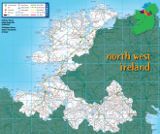North West Ireland Tourism
Visitor Guide to Mayo, Sligo, Donegal, Roscommon, Leitrim, Cavan & Monaghan
Visitor Guide to Mayo, Sligo, Donegal, Roscommon, Leitrim, Cavan & Monaghan
| 0-9 A B C D E F G H I J K L M N O P Q R S T U V W X Y Z |
The Giants Causeway
The Giant's Causeway is simply remarkable! It's like nothing you've seen anywhere before, and people come from all corners of the earth to witness the extraordinary progeny of white molten lava and cold Atlantic water on a biblical scale.
For centuries countless visitors have marveled at the extraordinary majesty and mystery of The Giant's Causeway. At the heart of one of Europe’s most magnificent coastlines, The Giant's Causeway’s unique rock formations have, for millions of years, stood as a natural rampart against the unbridled ferocity of north Atlantic Ocean. The rugged symmetry of the columns, and their uniform planshape, never fail to intrigue and inspire the curious admirers who come so far to witness them. Indeed to stroll along The Giant's Causeway is to voyage way back in time to an era of volcanic turbulence and geological uncertainty.
Some 50 to 60 million years ago, during the Paleogene period, Antrim was subject to intense volcanic activity, when highly fluid molten basalt intruded through chalk beds to form an extensive lava plateau. As the lava cooled rapidly, contraction occurred. Horizontal contraction fractured in a similar way to drying mud, with the cracks propagating as the mass cooled, leaving pillar like structures, which are also fractured horizontally into “biscuits”. In many cases the horizontal fracture has resulted in a bottom face that is convex while the upper face of the lower segment is concave, producing what are called “ball and socket” joints. The size of the columns is primarily determined by the speed at which lava from the volcanic eruption. The extensive fracture network produced the distinctive columns seen today.
But in Ireland we like to paraphrase science with our own brand of myth, and our version of the technical explanation for The Giant's Causeway goes as follows. Legend tells of an Irish warrior called Fionn Mac Cumhaill who built a causeway to Scotland. One version of the legend tells that Fionn was challenged by a Scottish giant, Benandonner. Now Benandonner was much much larger than Fionn, so he tried to think of a way out the challenge. His wife, Oonagh, came up with an ingenious idea. When Benandonner crossed the bridge looking for him, Oonagh disguised Fionn as a baby and tucked him in a cradle. When Benandonner came, Oonagh told him that Fionn was out woodcutting, but he should be back soon. She showed him ‘Fionn’s son’. When Benandonner saw the size of the baby, he had no desire to see the father! Benandonner fled home in terror, ripping up the Causeway behind him, so the ‘enormous Finn MacCool’, would not follow him to Scotland.
But whatever the truth, The Giant's Causeway is quite spectacular, and should not be missed on any trip to Ireland!
Book Giants Causeway Accommodation
For centuries countless visitors have marveled at the extraordinary majesty and mystery of The Giant's Causeway. At the heart of one of Europe’s most magnificent coastlines, The Giant's Causeway’s unique rock formations have, for millions of years, stood as a natural rampart against the unbridled ferocity of north Atlantic Ocean. The rugged symmetry of the columns, and their uniform planshape, never fail to intrigue and inspire the curious admirers who come so far to witness them. Indeed to stroll along The Giant's Causeway is to voyage way back in time to an era of volcanic turbulence and geological uncertainty.
Some 50 to 60 million years ago, during the Paleogene period, Antrim was subject to intense volcanic activity, when highly fluid molten basalt intruded through chalk beds to form an extensive lava plateau. As the lava cooled rapidly, contraction occurred. Horizontal contraction fractured in a similar way to drying mud, with the cracks propagating as the mass cooled, leaving pillar like structures, which are also fractured horizontally into “biscuits”. In many cases the horizontal fracture has resulted in a bottom face that is convex while the upper face of the lower segment is concave, producing what are called “ball and socket” joints. The size of the columns is primarily determined by the speed at which lava from the volcanic eruption. The extensive fracture network produced the distinctive columns seen today.
But in Ireland we like to paraphrase science with our own brand of myth, and our version of the technical explanation for The Giant's Causeway goes as follows. Legend tells of an Irish warrior called Fionn Mac Cumhaill who built a causeway to Scotland. One version of the legend tells that Fionn was challenged by a Scottish giant, Benandonner. Now Benandonner was much much larger than Fionn, so he tried to think of a way out the challenge. His wife, Oonagh, came up with an ingenious idea. When Benandonner crossed the bridge looking for him, Oonagh disguised Fionn as a baby and tucked him in a cradle. When Benandonner came, Oonagh told him that Fionn was out woodcutting, but he should be back soon. She showed him ‘Fionn’s son’. When Benandonner saw the size of the baby, he had no desire to see the father! Benandonner fled home in terror, ripping up the Causeway behind him, so the ‘enormous Finn MacCool’, would not follow him to Scotland.
But whatever the truth, The Giant's Causeway is quite spectacular, and should not be missed on any trip to Ireland!
How to get to The Giant's Causeway
By bus, or car. Ulsterbus and the Antrim Coaster Bus connect The Giant's Causeway with several North Coast towns, including Portrush, Bushmills and Ballintoy. Alternatively take the A26, and A44, from Ballymena to Ballycastle, and then the A2 coast road to The Giant's Causeway.Where to stay near The Giant's Causeway
The Giant's Causeway has lots of good places to stay nearby including hotels, self-catering holiday homes, guesthouses and B&B's.Book Giants Causeway Accommodation
Explore more
The Giant's Causeway is surrounded by beautiful coastal towns. Don't miss Portbraddan and Ballintoy if you are travelling east, and don't miss Portballintrae, Bushmills, and Portrush, if you are travelling east.Things to do in The Giant's Causeway
- Explore the new award-winning Causeway Experience Building by Heneghan Peng Architects, and enjoy its sloping grassed roofs. Very unusual and interesting.
- Enjoy the extraordinary topography of the Causeway steppes, a fascinating, almost lunar, landscape, and rent an audio-guide if you wish to know more about its formation all those years ago.
- Return home by way of the cliff walk, a very challenging but rewarding walking path which climbs the steep hill to the flat ground immediately above. Enjoy its views ans its vistas, and keep an eye out for occasional clusters of columns on the way.






